#guayota
Text
Happy Summer solstice!



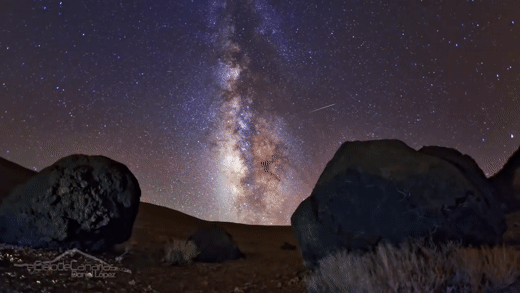
Here's a little legend about the Summer solstice I'd like to share with you, which relates with Saint John's day and Litha with the bonfire thing.
Basically, in the canarian island of Tenerife, they say inside the big volcano called Teide a god called Guayota (evil and very angry guy) is caged and sleeps in constant hibernation. Legend says that when the Teide erupts is because he wakes up, and he intends to do that when summer comes.
The original folks from Tenerife got the idea of lighting bonfires on the Summer Solstice so when Guayota opens his eyes to see if it's summer already he sees the bonfires and thinks it's still winter.
It's not exactly the most ellaborate (also I don't remember much more detail) story ever but I think it's pretty cool.

#litha#summer solstice#happy litha#summer is here#summer sabbat#happy sabbath#sabbat#guayota#volcano lore#teide#tenerife#canary islands#witchcraft#bonfires
30 notes
·
View notes
Photo


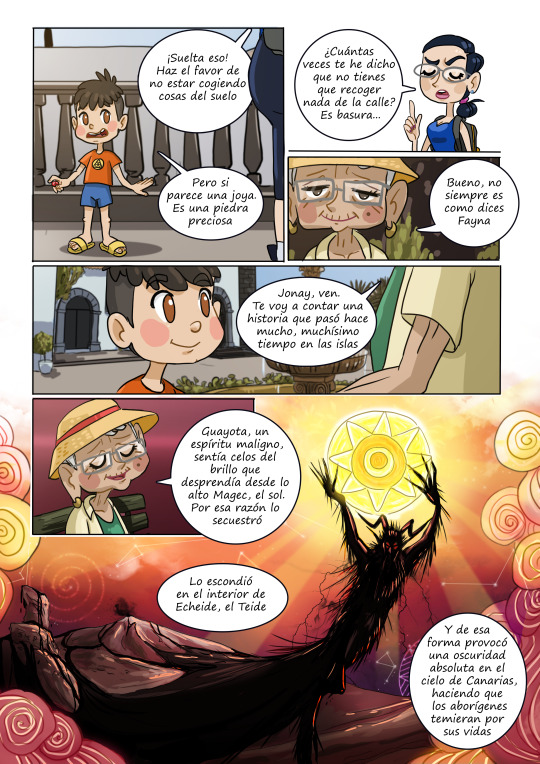
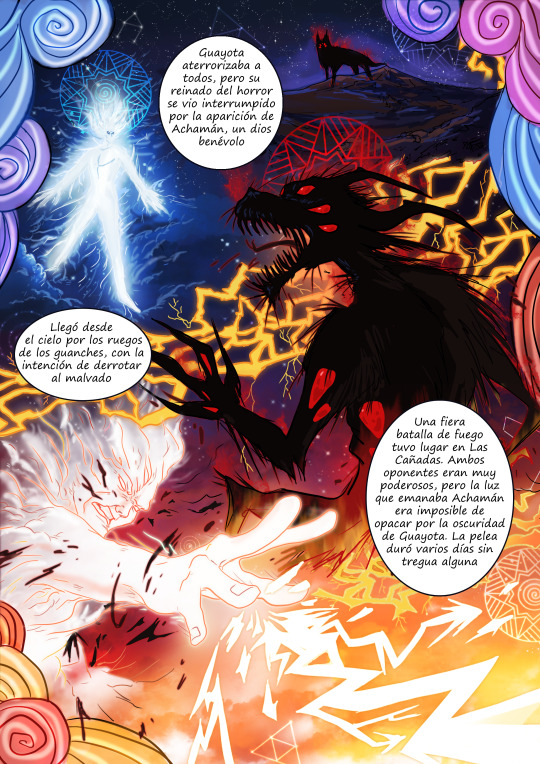
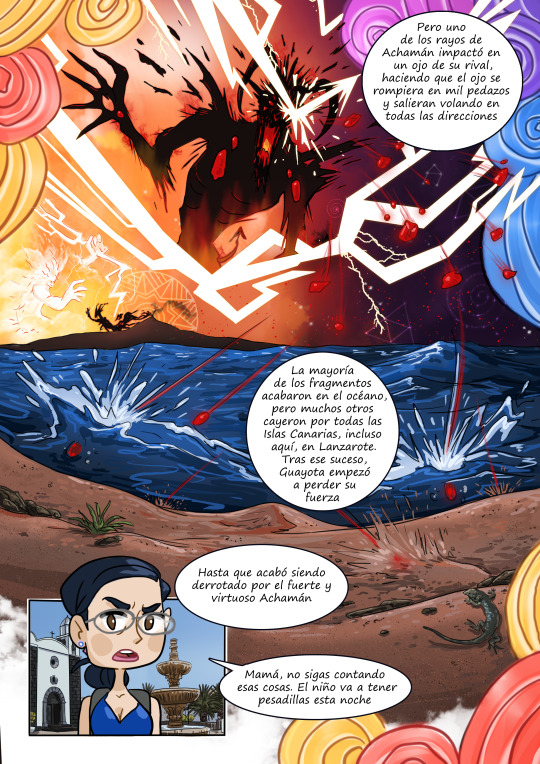
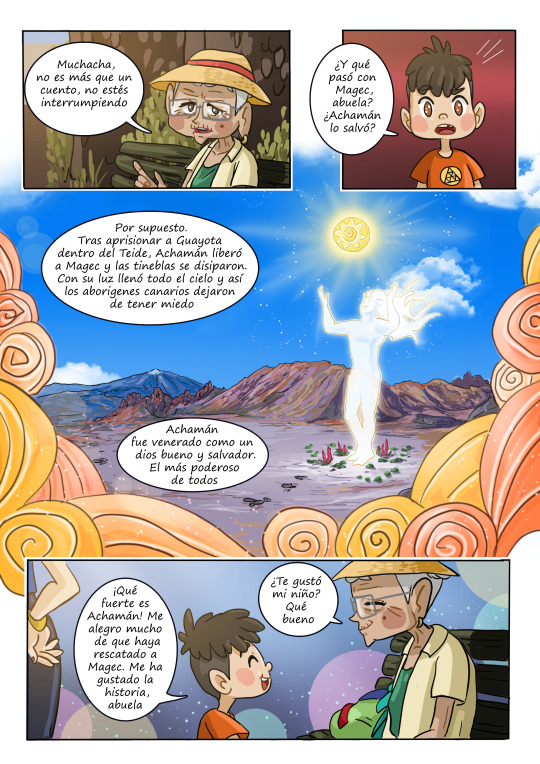

El ojo de Guayota
2° premio del XIV Edición Certamen Crea Joven San Bartolomé 2022
Una familia tinerfeña está de viaje en Lanzarote y, a su paso por San Bartolomé, la abuela le cuenta a su nieto una cuento sobre mitología canaria.
En agosto se me ocurrió la idea, en seis días dibujé, escribí, coloreé y maqueté este cómic, y mira por donde ha quedado segundo a nivel regional
https://www.instagram.com/jonas_emanuel_ilustrador/
#guayota#achaman#islas canarias#myth#comic#mitologia#mito#tenerife#teide#tebeo#gran canaria#el hierro#la palma#lanzarote#fuerteventura#la gomera#god#devil#demon#illustration#ilustracion#spain
7 notes
·
View notes
Photo
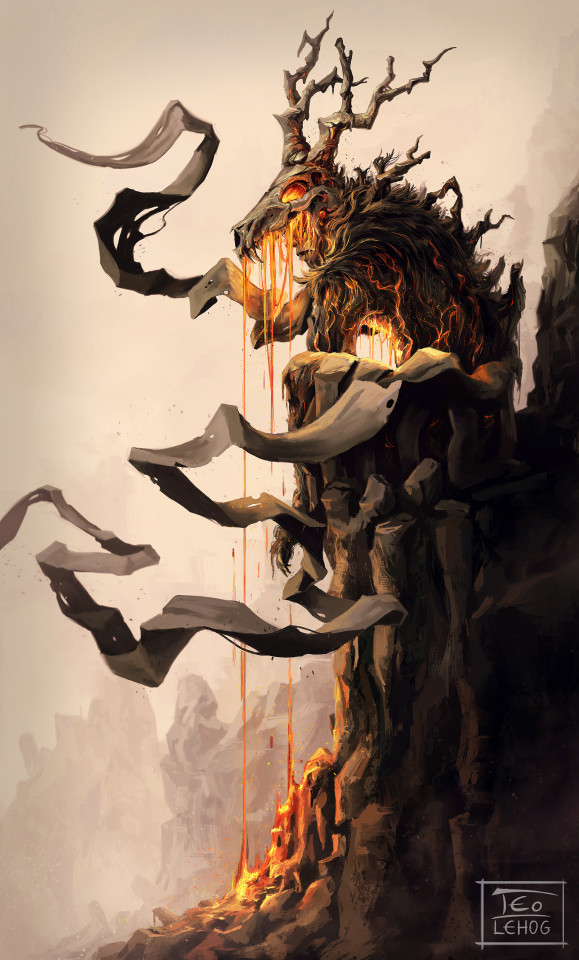
Guayota, a demon living inside the Teide Volano in the Canary Islands
by Théo Legouis / TeoLehog
This artist on Instagram
#art#illustration#digital art#dark art#horror#fantasy#mythology#folklore#demon#skull#fire#antlers#volcano
1K notes
·
View notes
Photo

The Tibicena [native Gran Canarian folklore]
An angry dog, especially a wild one, can pose a serious danger to both people and livestock. So it comes as little surprise that large, evil dogs are a very common recurring motive in folktales and myths from around the world.
In the legends of the native population of Gran Canaria, a large monstrous dog called the Tibicena plays an important role. This creature takes the appearance of a large dog with long black fur and bright red eyes. Tibicenas were evil spirits and after the arrival of Europeans, the Tibicena was also known as a form of the devil, but in the belief system of the original inhabitants these monsters were descendants of Guayota, a kind of demon or major evil spirit. Though the people of Gran Canaria use dogs as guardians and pets, wild dogs are also known to attack herds of livestock (which was a problem considering these animals were often the owners’ sole means to make a living) and supposedly even break into tombs to eat human corpses. The evil mythical creature likely originated from these negative connotations.
The monsters were said to live in caves, and even today some of the caverns in Gran Canarias are referred to as a ‘den of the Tibicena’. At night, they left the comfort of these caves to hunt, attacking both people and animals alike.
The Tibicena is analogous to the Cancha of Tenerife. Note that it’s unclear whether the Tibicena is supposed to be a singular demonic entity or a species of monsters, as this seems to vary between different sources.
Sources:
De Lavigne, G., 2015, Les Chiens Célèbres, Réels et Fictifs, dans l’art, la culture et l’histoire, Lulu, 572 pp.
De Abreu Y Galindo, J., 1632, The history of the discovery and conquest of the Canary Islands.
Alberto-Barroso, V., Delgado-Darias, T., Brito-Mayor, A. and Velasco-Vázquez, J., 2021, The ritualized use of dogs: considerations about their role in the mortuary belief system of the ancient Canarians, Canarias Arqueológica, 22:653-660.
Rodríguez, A. M. D., 2005, Recuperación y reconocimiento formal de la raza canina pastor garafiano, Revista de Estudios Generales de la Isla de La Palma, 1.
(image source: HoboMango on Twitter)
70 notes
·
View notes
Text
The Dictionnaire Infernal Demon Sigil's aren't all recorded but we sure do have Depiction artwork for every mentioned demon from A to Z:
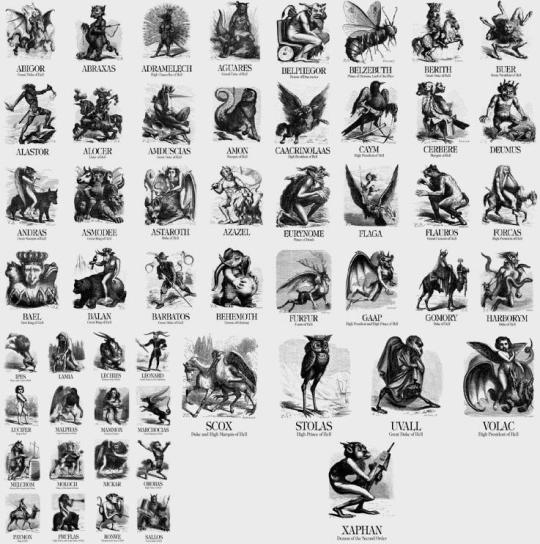
𖤐 Abbadon/Apollyon
𖤐 Abigor/Eligos
𖤐 Abraxas/Abracas
𖤐 Adramelech
𖤐 Aguares
𖤐 Alastor
𖤐 Alocer
𖤐 Amduscias
𖤐 Amon
𖤐 Andras
𖤐 Asmodee
𖤐 Astaroth
𖤐 Azazel
𖤐 Bael
𖤐 Balan
𖤐 Barbatos
𖤐 Behemoth
𖤐 Beleth or Berith
𖤐 Belphegor
𖤐 Beelzebub
𖤐 Bhairava / Beyrevra
𖤐 Buer
⛧ Caacrinolaas
⛧ Cali
⛧ Caym
⛧ Cerbere
𖤐 Deimos / Deumus
⛧ Eurynome / Euronymous
⛧ Flaga
⛧ Flavros
⛧ Forcas
⛧ Furfur
⛧ Ganga / Gramma
⛧ Garuda
⛧ Guayota
⛧ Gomory
⛧ Haborym
⛧ Ipes
⛧ Lamia
⛧ Lechies
⛧ Leonard
⛧ Lucifer
⛧ Malphas
⛧ Mammon
⛧ Marchosias
⛧ Melchom
𖤐 Moloch
⛧ Nickar
⛧ Nybbas
⛧ Orobas
⛧ Paimon
⛧ Picollus
⛧ Pruflas/Busas
⛧ Rahovart
⛧ Ribesal
⛧ Ronwe
⛧ Scox
𖤐 Stolas
⛧ Tap / Gaap
⛧ Torngarsuk
⛧ Ukobach
⛧ Volac
⛧ Xaphan
⛧ Yan-gant-y-tan
⛧ Zaebos
#Dictionnaire Infernal#pagan#joy of satan#spiritual satanism#deumus#satanism#paganism#deumo#dictionnaire infernal#magick#pagan witch#witchcraft#azazel#Lucifer#Beleth#stolas#buer#baal#bael#astaroth#demonology#grimiore#Louis Le Breton#Jacques Collin de Plancy#S. L. MacGregor Mathers#the lesser key of Solomon
8 notes
·
View notes
Text
TITEROGAKAT
(LANZAROTE)
Gracias a los compañeros de Nación Canaria por éste maravilloso reportaje en blanco y negro de nuestros antepasados que resurgen de las cenizas volcánicas (ahul guayota)

Nación Canaria
❤️ CONEJEROS/AS antes de la neocolonización turística.
Sin idealizar el pasado, sí urge valorar el sacrificio hecho por nuestros abuelos/as para sobrevivir de generación a generación durante siglos.
En islas como Titerogaka, sometidas a un señorío colonial, volcanes y con sequías periódicas, la sociedad conejera logró sobrevivir con duros trabajos. Labrando campos volcánicos, pastoreando y pescando en la costa sahariana, forjaron una identidad y una resistencia proverbial.
Hoy, con la isla totalmente inundada y en buena parte comprada por europeos, los canarios luchan por mantener su identidad en una ínsula que llegó a ser un referente del nacionalismo canario.
¿De verdad debemos permitir que nos expulsen de nuestro territorio ancestral y desaparecer como pueblo?
#lanzarote #titerogaka #titerogakalanzarote #conejeros #conejeras #mahoreros #mahos #mahoreras #canarios #canarias #pueblocanario #canariedad #historiadecanarias

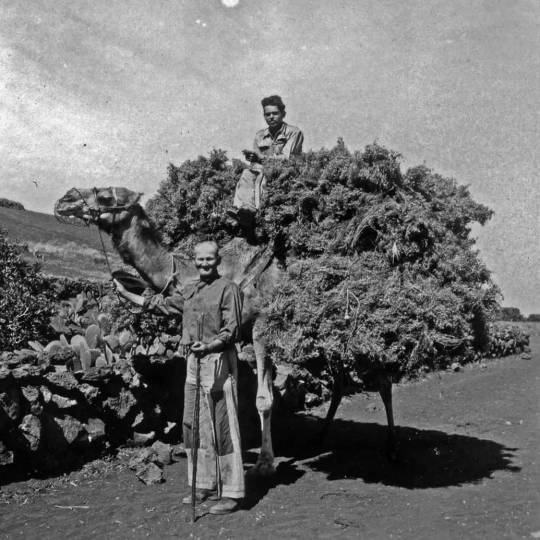
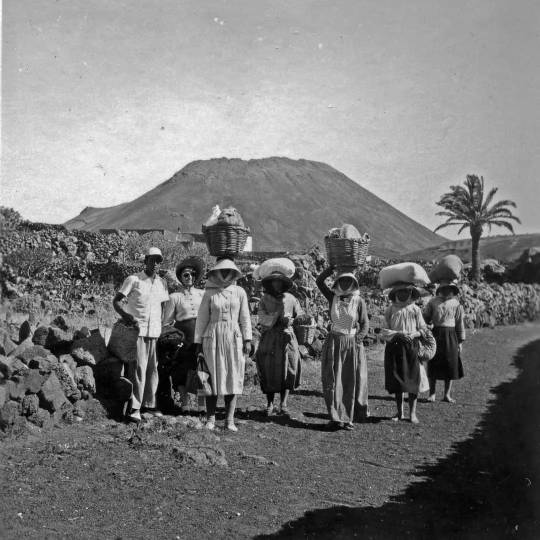


https://www.facebook.com/blognacioncanaria/posts/pfbid028xYZKU2MQbKqVbe1zdWn8A4Pz7nv7B5saBNxAHHpT9UBZNuRanBUVHHSfkhUTe54l?__cft__[0]=AZW6bkjOsCJSBDKrytMdIjrmxTkRJF2ILnwOO8cHdcM6K4mvFYQdRNLDsO0fl0DDV1ozork8nDD34QNWR1ZoddgrpU3hOfH99ya4uxCpoH0kefsPfq4y3qbO_nzTOceTgYuWeGXIHmKqo2UFqEsnGUkFs9ikgcuxUGa5SYzxP4vatQnsieJJDlaWNdTlGV1Vo7Y&__tn__=%2CO%2CP-R
#lanzarote#titerogakat#mahos#conejeros#canarios#aborigenous#indigenous#culture#history#genocide#native#unesco#united nations#international criminal court#cou penal international#corte penal internacional#africa#afrika#aborigines#indigenas#cultura#historia#genocidio#nativos#naciones unidas#canarias tiene identidad cultural propia#canarias la colonia mas antigua del mundo#descolonizacion de canarias#canarias#islas canarias
8 notes
·
View notes
Text
EU DESAFIO TODOS OS DEMÔNIOS EXISTENTES NO UNIVERSO A TIRAREM A VITÓRIA DO LULA NO 2º TURNO DAS ELEIÇÕES 2022

(ordem alfabética)
A- Abaddon (mitologia cristã) Abalam(mitologia cristã) Abezethibou (Testamento de Salomão) Abraxas/Abracas (Gnosticismo) Abyzou (mitologia judaica) Adrameleque (mitologia assíria, demonologia cristã) Aesma Daeva (zoroastrismo) Agaliarept (mitologia judaica) Agrat bat Mahlat (mitologia judaica) Agares (mitologia cristã) Agiel(mitologia judaica) Ahriman/Angra Mainyu (zoroastrismo) Aim/Haborym(mitologia cristã, Ars Goetia) Aka Manah/Akem Manah/Akoman/Akvan (zoroastrismo) Akira (mitologia bigottia) Ala(Mitologia eslava) Alal (mitologia caldeia) Alastor (mitologia cristã) Alloces/Allocer (mitologia cristã) Allu (mitologia acadiana) Alus Mabus (mitologia miliciana) Amaymon (mitologia cristã) Amdusias (mitologia cristã, Ars Goetia) Amy/Amousias(mitologia cristã) Anameleque (mitologia assíria) Andhaka (Mitologia hindu) Andras (mitologia cristã, Ars Goetia) Andrealfo (mitologia cristã, Ars Goetia) Andromálio (mitologia cristã, Ars Goetia) Anticristo(mitologia cristã) Armaros (mitologia judaica) Aariel (mitologia cristã, Ars Theurgia) Arconte (gnosticismo) Asag/Asakku (mitologia suméria) Asakku (mitologia babilônica) Asb'el (mitologia judaica) Asmodeus Astaroth Asura (mitologia hindu) Azazel / Azaz'el (mitologia judaica) Azi Dahaka/Dahak (zoroastrismo)
B- Baal/Bael (mitologia cristã) Balam (mitologia cristã) Barão (mitologia católica)[1] Balberith (mitologia judaica) Bali Raj (mitologia hindu) Banshee (mitologia irlandesa) Baphomet (folclore cristão Barbas (mitologia cristã) Barbatos (mitologia cristã) Bathin/Mathim/Bathym/Marthim(demonologia cristã) Beball (mitologia cristã) Belzebu (mitologia judaica, demonologia cristã) Behemoth (mitologia judaica) Belial (mitologia judaica, mitologia cristã) Beleth (mitologia cristã) Belphegor(mitologia cristã) Berith/Beherit(mitologia fenícia, mitologia cristã) Bhoot/Bhūta (Sanskrit) Bifrons (mitologia cristã) Boruta (mitologia eslava) Botis (mitologia cristã) Buer(mitologia cristã) Bukavac (demonologia eslava) Bune (mitologia cristã) Buta Kala (mitologia indonésia) Bushyasta (zoroastrismo)
C- Caifaz Carabia / Decarabia (mitologia cristã) Carmelo (mitologia cristã) Cramunhão Charún (mitologia etrusca) Chemosh (moabita) Choronzon(Thelema) Cimejes / Kimaris / Cimeries(mitologia cristã) Corson (mitologia cristã) Crocell / Procell (mitologia cristã) Culsu (mitologia etrusca)[2] Cérbero (mitologia grega)
D- Daeva (mitologia zoroastra) Dagon (mitologia semita)[3] Dajjal (mitologia islâmica)[4] Dantalion (mitologia cristã)[5] Danjal (mitologia judaica) Davy Jones (folclore nâutico)[6] Decarabia (mitologia cristã) Demiurgo (Gnosticismo) Demogorgon (mitologia cristã)[5] Drekavac (mitologia cristã)
E- Eisheth (mitologia judaica) Eligos (mitologia cristã) Équidna (mitologia grega)
F- Focalor (mitologia cristã) Foras/Forcas/Forras/ (mitologia cristã) Forneus (mitologia cristã) Furcas/Forcas (mitologia cristã) Furfur (mitologia cristã)
G- Gosfe (mitología japonesa) Gader'el (mitologia judaica) Gaki (mitologia japonesa) Gamigin (mitologia cristã) Ghoul (Árabe e outras mitologias) Glasya-Labolas/Caacrinolaas/Caassimolar/Classyalabolas/Glassia-labolis (demonologia cristã). Gords- Demônio dos mil dedos (Demonologia popular) Górgona (mitologia grega) Gremory/Gomory (demonologia cristã) Grigori (mitologia judaica) Gualichu (mitologia mapuche) Guayota (Guanche) Gusion/Gusoin/Gusoyn
H- Haagenti (mitologia cristã) Halphas/Malthus (mitologia cristã) Hantu Raya (mitologia indonésia) Haures/Flauros/Flavros/Hauras/Havres (mitologia cristã)
I- Ifrit Íncubo Iblis Imp Ipos/Ipes (mitologia cristã)
J- Jinn (mitologia islâmica) Jikininki (mitologia japonesa)
K- Kabandha/Kabhanda (Hinduismo) Kali (Hinduismo) Karen (mitologia nórdica) Kasadya (mitologia judaica) Kokabiel (mitologia judaica) Kroni (mitologia Ayyavazhi) Kermani (mitologia nórdica)
L- Lâmia Legião (mitologia cristã) Lechies (mitologia eslava) Leyak (mitologia indonésia) Lempo (mitologia finlandesa) Leraje/Leraie (mitologia cristã) Leviatã (mitologia judaica, mitologia cristã) Lili/Lilin/Lilim (mitologia judaica) Lilith (mitologia acádia, mitolofia suméria e folclore judaico) Lúcifer (mitologia cristã) Lucifuge Rofocale (mitologia cristã)
M- Malphas (mitologia cristã) Mammon (mitologia cristã) Mara (mitologia budista) Maricha (mitologia hindu)[7] Matin (mitologia das baleias) Marax/Morax/Foraii (mitologia cristã) Marchosias (mitologia cristã) Masih ad-Dajjal/Ad-Dajjal/Dajjal (escatologia islâmica)[8] Mastema (mitologia judaica) Medusa (mitologia grega) Mephistopheles (folclore cristão, folclore alemão) Merihem (mitologia cristã e judaica) Minotauro (mitologia grega) Moloch (mitologia cristã) Murmur (mitologia cristã) Morfeu (mitologia grega)
N- Naamah (mitologia judaica) Naberius/Cerbere/Naberus (mitologia cristã) Ninurta[9] Namtar
O- Onoskelis Orcus Orias/Oriax (mitologia cristã) Orobas (mitologia cristã) Ose (mitologia cristã) Ördög (mitologia húngara) O Tokata
P- Paimon (mitologia cristã) Pazuzu (mitologia babilônica) Pelesit (mitologia indonésia) Phenex (mitologia cristã) Penemue (mitologia cristã e judaica) Pithius (mitologia cristã) Pocong (mitologia indonésia) Pontianak Procrusto (mitologia grega) Pruflas (mitologia cristã) Puloman (Hindu demonology)
Q- Quimera (Mitologia Grega)
R- Rahab (folclore judaico) Raum (mitologia cristã) Ronove (mitologia cristã) Rusalka (mitologia eslava) Rakshasa (hinduísmo) Rangda (hinduísmo) Ravan (hinduísmo)
S- Sabnock (mitologia cristã) Saleos (mitologia cristã) Salpsan (mitologia cristã) - filho de Satã, de acordo com Evangelho de Bartolomeu. Samael (demonologia judaica) Seir (mitologia cristã) Semyaz (demonologia judaica) Shax/Chax (mitologia cristã) Shedim (folclore judaico) Sithis (mitologia nórdica) Sitri (mitologia cristã) Sthenno (mitologia grega) Stolas/Solas (mitologia cristã) Suanggi Súcubo (mitologia cristã, suméria) Surgat (mitologia cristã)
T- Tannin (mitologia judaica) Toyol
U- Ukobach (mitologia cristã)
V- Valac (mitologia cristã) Valefary/Malaphar/Malephar (mitologia cristã Vapula (mitologia cristã) Vassago (mitologia cristã) Vepar (mitologia cristã) Vine (mitologia cristã)
W- Wendigo (Algonquin)
X- Xaphan (mitologia cristã) Xezbeth
Y- Yeqon Yeter'el
Z- Zagan (mitologia cristã) Zepar (mitologia cristã) Ziminiar (mitologia cristã) Zozo (Ouija) Zulu Bangu (mitologia africana)
CAIAM DENTRO PANACAS, EU QUEBRO TODOS VOCÊS
2 notes
·
View notes
Text
Teide

Teide (o Pic del Teide) és un estratovolcà i muntanya de Tenerife, Illes Canàries (28.27 N, 16.6 O). Amb una altitud de 3718 m sobre el nivell del mar i amb aproximadament uns 7000 m sobre el llit marí adjacent, és la muntanya més alta d'Espanya, la muntanya més alta de totes les illes atlàntiques i el tercer volcà més gran de la Terra. El Teide data de tipus d’erupcions desde el tipus estrombolià fins al tipus plinià. Aquest edifici volcànic es troba dins de l’antic edifici volcànic canyada reial el qual alberga alguns cràters d’erupcions monogenètiques com Narices del Teide que només són del tipus d'erupció hawaiana. Combinant el sistema estrombolià amb l’anterior es crea el tipus de sistema eruptiu més comú a les illes Canàries.
Atès el seu historial eruptiu i la seva localització propera a centres poblats, el volcà ha estat designat com un dels 16 Volcans de la Dècada pel seu gran valor en l'estudi de la reducció de futurs desastres naturals. Es troba en repòs, amb una darrera erupció documentada l'any 1909 pel bufador subsidiari de Chinyero, al pendent oest del Teide. Altres erupcions destacades van ocórrer els anys 1704-1706 i 1798. El cim té algunes petites i actives fumaroles que emeten diòxid de sofre calent, així com d'altres gasos. Existeix una probabilitat mitjana-alta de futures erupcions, incloent el risc d'alguna d'altament perillosa del tipus piroclàstic com les dels Mont Pelée i Vesuvi. El nom Teide és una evolució castellana del nom originari Guanxe "Echeyde", anterior a la colonització castellana. Echeyde, a les llegendes Guanxes, era el nom donat al seu infern, on vivia una poderosa figura (Guayota) una mena de guardià de la porta d'aquell inframón.[cal citació]
A la prehistòria, fa uns 180 000 anys, un volcà encara més gran que el Teide va patir una explosió gegantina d'índex 7, que va fraccionar el pic deixant-lo lliscar fins al mar pel nord de l'illa, creant així les anomenades Cañadas del Teide, una gran caldera just per sobre dels 2500 m d'altitud, amb 15 km d'amplada d'est a oest i 10 km d'amplada de nord a sud. Al costat sud, els murs interns del cràter formen un penya-segat que va dels 2.715 m als 2 100 m a Guajara. El mateix cim del Teide i el bufador subsidiari anomenat Pico Viejo (3135 m),[1] tots dos al costat nord de la caldera, deriven d'erupcions que van seguir a la gran explosió prehistòrica.
El volcà i els seus voltants formen el Parc Nacional del Teide, que ha estat considerat Patrimoni de la Humanitat per la UNESCO. S'hi accedeix per una carretera pública que travessa la caldera de nord-est a sud-oest. Un telefèric surt des d'aquesta carretera a uns 2356 m i arriba gairebé al cim (3555 m). L'accés al cim és restringit, i cal un permís per ascendir els darrers 200 m. En 2016, va ser visitat per 4 079 823[2][3] visitants i turistes arribant a un rècord històric. A més és el parc nacional més visitat d'Espanya, d'Europa i actualment el novè del món.[4][5]
El Teide destaca també per gran nombre d'endemismes botànics. Plantes, com el Cytisus supranubius (Retama del Teide), l'Echium wildpretii (Tajinaste rojo); una espectacular espècie de boraginàcia que pot arribar als 3 m d'alçada, i lErysium -Scoparium, una espècie de planta roquera. Als pendents d'alçada entre 1000 i 2000 m s'hi troben boscos de Pinus canariensis (Pi Canari).
Els romans denominaven a l'illa Nivaria, per la neu del volcà. El nom actual de l'illa també guarda relació amb el volcà, atorgat pels Benehaorites (aborígens de l'illa de La Palma). "Tene-" (muntanya) "-ife" (blanca), i la posterior castellanització del nom, va provocar que s'afegís una -r enmig.
En el quadern de bitàcola de Cristòfol Colom apareix una referència al Teide en erupció.
1 note
·
View note
Video
youtube
SACRED 40 YEARS MAUNA LOA & THE RETURN OF TUTU PELE GODDESS OF FIRE! AbodeHalemaʻumaʻuSymbolfire, volcanoPersonal informationParentsHaumeaKu-waha-iloSiblingsHiʻiakaNāmakaKapoKamohoaliiKāne MilohaiIn different stories talking about the goddess Pele, she was born from the female spirit named Haumea. This spirit is important when talking about Hawaiʻi's gods as she descended from Papa, or Earth Mother, and Wakea, Sky Father, both descendants of the supreme beings. Pele is also known as "She who shapes the sacred land," known to be said in ancient Hawaiian chants.[3][4] The first published stories of Pele were written by William Ellis.[5]: 5 LegendsEditAccording to legend, Pele lives in Halemaʻumaʻu of Kīlauea in Hawaiʻi Volcanoes National Park.Kīlauea is a currently active volcano that is located on the island of Hawaiʻi and is still being extensively studied.[6] Many Hawaiians believe Kilauea to be inhabited by a "family of fire gods," one of the sisters being Pele who is believed to govern Kilauea and is responsible for controlling its lava flows.[7] There are several traditional legends associated with Pele in Hawaiian mythology. In addition to being recognized as the goddess of volcanoes, Pele is also known for her power, passion, jealousy, and capriciousness. She has numerous siblings, including Kāne Milohai, Kamohoaliʻi, Nāmaka, and numerous sisters named Hiʻiaka, the most famous being Hiʻiakaikapoliopele (Hiʻiaka in the bosom of Pele). They are usually considered to be the offspring of Haumea. Pele's siblings include deities of various types of wind, rain, fire, ocean wave forms, and cloud forms. Her home is believed to be the fire pit called Halemaʻumaʻu at the summit caldera of Kīlauea, one of the Earth's most active volcanoes, but her domain encompasses all volcanic activity on the Big Island of Hawaiʻi.[8]Pele shares features similar to other malignant deities inhabiting volcanoes, as in the case of the devil Guayota of Guanche Mythology in Canary Islands (Spain), living on the volcano Teide and was considered by the aboriginal Guanches as responsible for the eruptions of the volcano.[9]Legend told that Pele herself journeyed on her canoe from the island of Tahiti to Hawaiʻi. When on her journey, it was said she tried to create her fires on different islands, but her sister, Nāmaka, was chasing her, wanting to put an end to her. In the end, the two sisters fought each other and Pele was killed. With this happening, her body was destroyed but her spirit lives in Halemaʻumaʻu on Kilauea. They say, "Her body is the lava and steam that comes from the volcano. She can also change form, appearing as a white dog, old woman, or beautiful young woman."[10]In addition to her role as goddess of fire and her strong association with volcanoes, Pele is also regarded as the "goddess of the hula."[11] She is a significant figure in the history of hula because of her sister Hiʻiaka, who is believed to be the first person to dance hula.[12] As a result of Pele's significance in hula, there have been many hula dances and chants dedicated to her and her family. With hula being dedicated to Pele, the dance is often performed in a way that represents her intense personality and the movement of volcanoes.[
1 note
·
View note
Text
Guayota's lament: this is how the last seismic swarm sounds on El Teide
Guayota’s lament: this is how the last seismic swarm sounds on El Teide
Guayota: Guayota’s Lament. This is how the seismic swarm of hybrid events that is being recorded right now under the Teide volcano sounds. To make the frequencies of these seismic signals heard by humans we had to speed them up 500 times. In this video you can see and hear the seismic signals recorded by the Canarian Seismic Network, operated by Involcan, between 05:50 and 08:50 (Canarian time)…

View On WordPress
0 notes
Photo
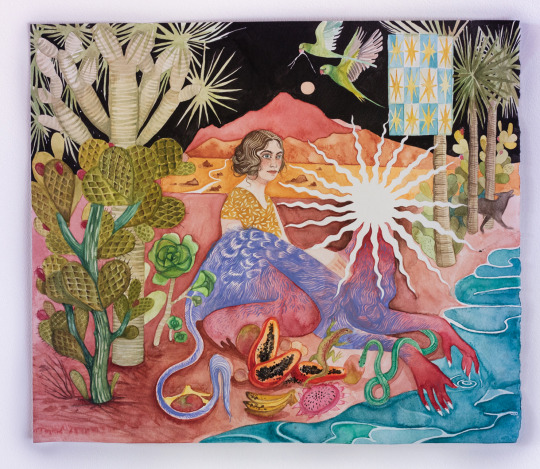
Aleksandra Czudżak
-
Self-portrait on Tenerife. With Guayota.
#tenerife#canaries#papaya#exotic#tropical island#contemporary illustration#watercolour#self portrait#animal#canary island#magic art#femine#hybrid#fur#nature#ilustrace#ilustracao#ilustradora#ilustração#guayota#aleksandra czudżak#czudżak
205 notes
·
View notes
Photo
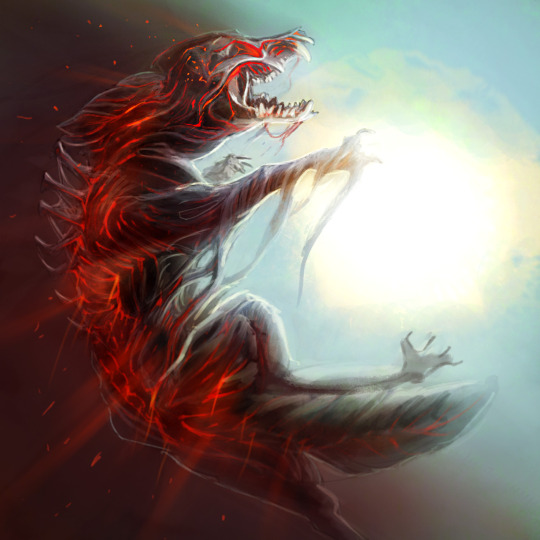
Creatuanary day 8 - Guayota. Another malign spirit from the Canary isles, Guayota is the biggest and baddest among the Tibicena. Legends say that he once snatched the sun from the sky and imprisoned it in the Tiede volcano.
59 notes
·
View notes
Text


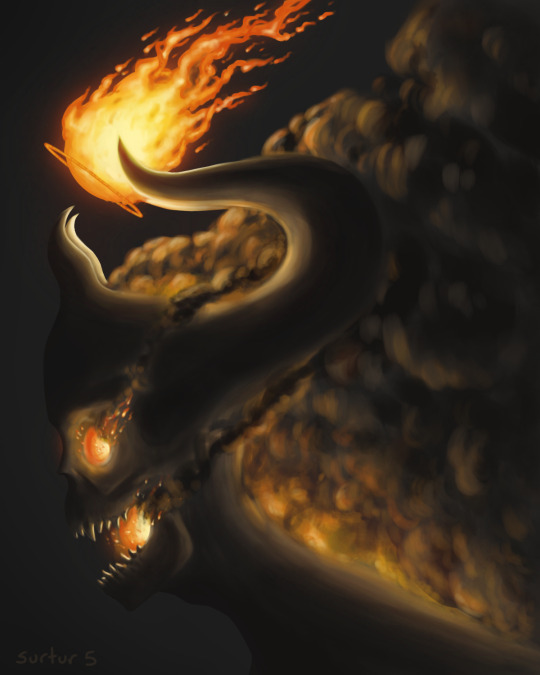
And now for demon designs
#art#illustration#drawing#digital art#digital illustration#mine#demon#dog#dog monster#surtur#tibicenas#guayota#horns#mythology#drawing prompt
9 notes
·
View notes
Text
ALEGATO DE UNA DESCENDIENTE DIRECTA DE LOS ABORIGENES CANARIOS

G Ancor Kanarii
Lydia Hdez:
"Los criollos no te dejan producir aquí y si produces te arruinan. Durante décadas, hemos tenido , espero que no vuelva a ocurrir... 16 millones de bocas que llenar en la colonia y ese ha sido el gran negocio del importador, de España y del productor de fuera.
Imaginen, no sólo es la papa gedionda con g... que nos hemos estado comiendo, es todo. Fruta, carne, pescado, huevos,leche,queso, etc. Hasta una simple mermelada. Y todo eso, se podía haber fabricado aquí en un altísimo porcentaje.
Una industria que hubiera dejado en manos de los canarios muchísimo dinero. No producimos ni para nosotros.
Ahora mismo, si no entra nada de fuera, nos matan de hambre.
Así que, estamos tardando en poner el puño sobre la mesa de un buen golpe y parar ésta colonización.
Acaso es tan brutal el síndrome de Estocolmo y del colonizado en nuestro pueblo, que hemos creído que sólo valemos para servir y construir hoteles y residenciales para godos y turistas?? 🤔
En serio??"

A la izquierda la montaña de Ajodar en Galdar "AGALDAR" la primera capital del Guanartemato "Reino" de Canaria hoy es la isla de "Gran Canaria"
A la derecha papá Teide "Echeyde" en Tenerife "Achinech" el volcán y señor de Taknara "Canarias" único señor de las islas canarias donde reside Guayota "Rey Del Fuego" señor del reino de los fuegos.
G Ancor Kanarii
Favoritos · ·
Lydia Hdez:
"Los criollos no te dejan producir aquí y si produces te arruinan. Durante décadas, hemos tenido , espero que no vuelva a ocurrir... 16 millones de bocas que llenar en la colonia y ese ha sido el gran negocio del importador, de España y del productor de fuera.
Imaginen, no sólo es la papa gedionda con g... que nos hemos estado comiendo, es todo. Fruta, carne, pescado, huevos,leche,queso, etc. Hasta una simple mermelada. Y todo eso, se podía haber fabricado aquí en un altísimo porcentaje.
Una industria que hubiera dejado en manos de los canarios muchísimo dinero. No producimos ni para nosotros.
Ahora mismo, si no entra nada de fuera, nos matan de hambre.
Así que, estamos tardando en poner el puño sobre la mesa de un buen golpe y parar ésta colonización.
Acaso es tan brutal el síndrome de Estocolmo y del colonizado en nuestro pueblo, que hemos creído que sólo valemos para servir y construir hoteles y residenciales para godos y turistas?? 🤔
En serio??"
#travel#vacation#colonization#colonialism#aborigenous#indigenous#culture#history#genocide#native#unesco#international criminal court#cou penal international#corte penal internacional#viajes#vacaciones#colonizacion#colonialismo#aborigines#indigenas#cultura#historia#genocidio#nativos#united nations#naciones unidas#descolonizacion de canarias#canarias la colonia mas antigua del mundo#canarias tiene identidad cultural propia#islas canarias
3 notes
·
View notes
Quote
"So," she said carefully, "Juan Flores is really a volcanic deity names Guayota who thinks that your ex-wife Christy is–what?–some sort of reincarnation of the sun goddess he captured and raped thousands of years ago?"
"I know, right?" I said, swallowing hastily. "I had that same moment of disbelief. But for me it was when he threw his finger at me, and it burned through the top of the Passat I was standing on."
Night Broken, by Patricia Briggs
#page 174#night broken#patricia briggs#mercy thompson#quote#quotes#literature#book#booklr#reading#lucia arocha#guayota
18 notes
·
View notes